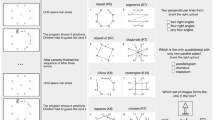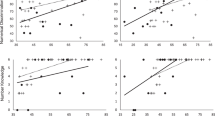Abstract
Symbolic arithmetic is fundamental to science, technology and economics, but its acquisition by children typically requires years of effort, instruction and drill1,2. When adults perform mental arithmetic, they activate nonsymbolic, approximate number representations3,4, and their performance suffers if this nonsymbolic system is impaired5. Nonsymbolic number representations also allow adults, children, and even infants to add or subtract pairs of dot arrays and to compare the resulting sum or difference to a third array, provided that only approximate accuracy is required6,7,8,9,10. Here we report that young children, who have mastered verbal counting and are on the threshold of arithmetic instruction, can build on their nonsymbolic number system to perform symbolic addition and subtraction11,12,13,14,15. Children across a broad socio-economic spectrum solved symbolic problems involving approximate addition or subtraction of large numbers, both in a laboratory test and in a school setting. Aspects of symbolic arithmetic therefore lie within the reach of children who have learned no algorithms for manipulating numerical symbols. Our findings help to delimit the sources of children’s difficulties learning symbolic arithmetic, and they suggest ways to enhance children’s engagement with formal mathematics.
This is a preview of subscription content, access via your institution
Access options
Subscribe to this journal
Receive 51 print issues and online access
$199.00 per year
only $3.90 per issue
Buy this article
- Purchase on Springer Link
- Instant access to full article PDF
Prices may be subject to local taxes which are calculated during checkout


Similar content being viewed by others
References
Baroody, A. J. & Dowker, A. The Development of Arithmetic Concepts and Skills: Constructing Adaptive Expertise (Erlbaum, Mahwah, New Jersey, 2003)
Geary, D. From infancy to adulthood: the development of numerical abilities. Eur. Child Adoles. Psychiat. 9, 11–16 (2000)
Gallistel, C. R. & Gelman, R. Preverbal and verbal counting and computation. Cognition 44, 43–74 (1992)
Dehaene, S. The Number Sense (Oxford Univ. Press, Oxford, UK, 1997)
Lemer, C., Dehaene, S., Spelke, E. & Cohen, L. Approximate quantities and exact number words: dissociable systems. Neuropsychologia 41, 1942–1958 (2003)
Hauser, M. D. & Spelke, E. S. in The Cognitive Neurosciences (ed. Gazzaniga, M.) Vol. 3 853–864 (MIT Press, Cambridge, Massachusetts, 2004)
McCrink, K. & Wynn, K. Large number addition and subtraction by 9-month-old infants. Psychol. Sci. 15, 776–781 (2004)
Barth, H., La Mont, K., Lipton, J. & Spelke, E. S. Abstract number and arithmetic in preschool children. Proc. Natl Acad. Sci. USA 102, 14116–14121 (2005)
Barth, H. et al. Non-symbolic arithmetic in adults and young children. Cognition 98, 199–222 (2006)
Pica, P., Lemer, C., Izard, V. & Dehaene, S. Exact and approximate arithmetic in an Amazonian indigene group. Science 306, 499–503 (2004)
Zur, O. & Gelman, R. Young children can add and subtract by predicting and checking. Early Child. Res. Q. 19, 121–137 (2004)
Griffin, S. & Case, R. Evaluating the breadth and depth of training effects when central conceptual structures are taught. Monogr. Soc. Res. Child Dev. 61, 83–102 (1996)
Lipton, J. S. & Spelke, E. S. Preschool children’s mapping of number words to nonsymbolic numerosities. Child Dev. 76, 978–988 (2005)
Le Corre, M., Van de Walle, G., Brannon, E. M. & Carey, S. Re-visiting the competence/performance debate in the acquisition of the counting principles. Cogn. Psychol. 52, 130–169 (2006)
Temple, E. & Posner, M. I. Brain mechanisms of quantity are similar in 5-year-old children and adults. Proc. Natl Acad. Sci. USA 95, 7836–7841 (1998)
van Oeffelen, M. P. & Vos, P. G. A probabilistic model for the discrimination of visual number. Percept. Psychophys. 32, 163–170 (1982)
Ashcraft, M. H. & Fierman, B. A. Mental addition in 3rd, 4th, and 6th graders. J. Exp. Child Psychol. 33, 216–234 (1982)
LeFervre, J.-A., Smith-Chant, B. L., Hiscock, K., Daley, K. E. & Morris, J. in The Development of Arithmetic Concepts and Skills: Constructing Adaptive Expertise (eds Baroody, A.J. & Dowker, A.) 203–228 (Erlbaum, Mahwah, New Jersey, 2003)
Feigenson, L., Dehaene, S. & Spelke, E. S. Core systems of number. Trends Cogn. Sci. 8, 307–314 (2004)
Acknowledgements
We thank C. Katz and R. Lizcano for help with data collection. This work was supported by a ROLE grant from the National Science Foundation (to E.S.S.).
Author information
Authors and Affiliations
Corresponding authors
Ethics declarations
Competing interests
Reprints and permissions information is available at www.nature.com/reprints. The authors declare no competing financial interests.
Supplementary information
Supplementary Information
This file contains Supplementary Methods and Analyses, Supplementary Tables 1 – 5 and Supplementary Figures 1 – 4 with Legends. This document contains a list of problems used in the experiments, a description of the tests of school achievement and their relation to performance of symbolic approximate arithmetic, and a description of all the tests for guessing strategies. (PDF 727 kb)
Rights and permissions
About this article
Cite this article
Gilmore, C., McCarthy, S. & Spelke, E. Symbolic arithmetic knowledge without instruction. Nature 447, 589–591 (2007). https://doi.org/10.1038/nature05850
Received:
Accepted:
Issue Date:
DOI: https://doi.org/10.1038/nature05850
This article is cited by
-
Literacy Rather than Non-verbal Number Sense Predicts Kindergarteners’ Numerical Abilities
Journal of Child and Family Studies (2023)
-
Influences of basic numerical abilities on graph reading performance
Psychological Research (2020)
-
Risk approximation in decision making: approximative numeric abilities predict advantageous decisions under objective risk
Cognitive Processing (2018)
-
Configured-groups hypothesis: fast comparison of exact large quantities without counting
Cognitive Processing (2017)
-
Monkeys display classic signatures of human symbolic arithmetic
Animal Cognition (2016)
Comments
By submitting a comment you agree to abide by our Terms and Community Guidelines. If you find something abusive or that does not comply with our terms or guidelines please flag it as inappropriate.



